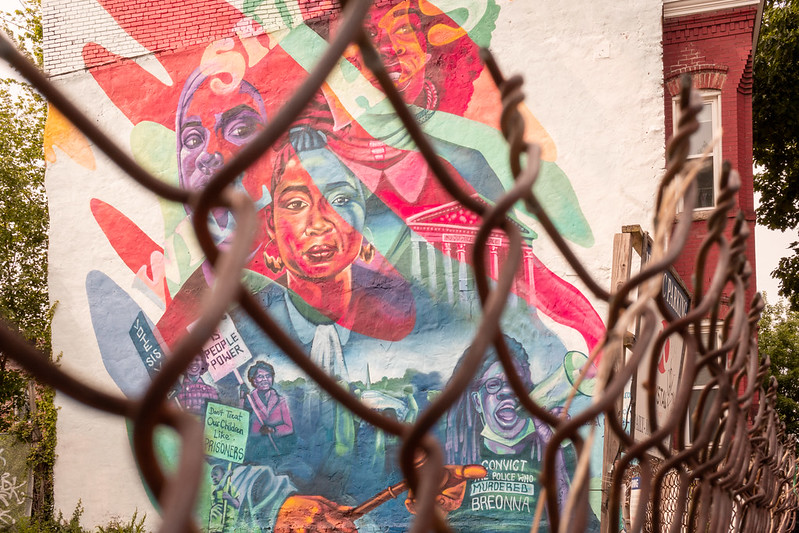
Intersectionality and its close cousin critical race theory have become buzzwords in American politics. But what does intersectionality mean and why does it matter?
It’s Good to Know what Intersectionality is (and what it isn’t).
Intersectionality in a nutshell
Legal scholar Kimberlé Crenshaw is widely credited with drawing on critical race theory – a framework that implicates laws and institutions in the creation and maintenance of racial hierarchies – to introduce intersectionality in a 1989 article that posited that racism and sexism should not be considered mutually exclusive.
Crenshaw built this theory by centering the experiences of Black women plaintiffs in employment discrimination cases. She explained that the typical practice of adjudicating these claims is to use the experiences of Black men as the standard for racial discrimination and white women as the benchmark for gender discrimination. Intersectionality was coined to describe how Black women are erased as a result of thinking about the effects of power – racism and sexism in her example – along just one axis.
Crenshaw argued that a more robust approach to justice in this case and others like it would be to examine the ways that racism and sexism are impossible to tease apart in the prevailing political and social context of what bell hooks referred to as the white supremacist capitalist patriarchy.
Intersectionality is a structural critique of power
Many misunderstand intersectionality, believing inaccurately that this analytic perspective simply calculates the number of marginalizations that individuals face to determine who is most negatively affected, resulting in “oppression olympics.” Others critique intersectionality by arguing that it insufficiently theorizes structural conditions – specifically class exploitation – which these critics argue do not necessarily map onto race and gender. These conclusions are the result of misreading intersectionality at an individual level of analysis. But Crenshaw and other intersectional theorists go to great lengths to elaborate that intersectionality is a structural critique of power.
Take, for example, the name itself. Intersectionality derives from a metaphor Crenshaw sketched in which cars simultaneously arrive at an intersection and collide. The point, she argued, was not that the resulting injury might be worse due to the number of cars involved. The problem for scholars and activists to contend with was that the intersection existed as a place for the accident to occur. In other words, intersectionality draws attention to the structures (e.g., laws, policies, etc.) that create precarious conditions.
Scholars across many fields build on intersectionality’s structural critique by highlighting how deeply intertwined dominant ideologies – such as white supremacy, sexism, heteronormativity, ableism, classism, Christian normativity, and citizenship – shape people’s daily lives.
Why does intersectionality matter today?
Despite this explicit focus on structure and ideology, many of the attacks that have recently been leveled against critical race theory argue that intersectionality does the opposite. These attacks treat it as a theory of individual-level marginalization that actually privileges remedying discrimination confronted by Black people at the expense of all others. This logic informs the wave of attacks against teaching about race in schools and a recent claim by a Pennsylvania State University professor who says he was subject to racism as a white person during a critical race theory training for instructors.
Intersectionality and political science
A substantial and growing body of empirical scholarship leverages intersectionality to highlight the effects of within-group marginalization, beginning with Cathy J. Cohen’s 1999 book Boundaries of Blackness: AIDS and the Breakdown of Black Politics. Dara Strolovitch shows how interest groups systematically fail to represent the interests of their most marginalized members. Cristina Béltran unpacks “Latino” as a pan-ethnic category to reveal how the most privileged members of that group, such as wealthy Cubans, exert influence over the group’s agenda. Nadia E. Brown uses intersectionality to explore how racist and sexist ideals of womanhood shape Black women’s experiences of running for office.
These examples and others like them draw attention to the elevation of some members of a group at the expense of others. This research also highlights the usefulness of intersectionality for developing critical perspectives on ideologies, laws, identities, and institutions. In sum, intersectionality is a cogent lens for analyzing power, which is a central concern in political science.
Intersectionality in Good Authority
- Chaya Crowder, “June’s rallies for Black transgender lives can change attitudes and policies. Here’s how.“ From June 2020, this post examines solidarity across various forms of discrimination faced by Black transgender people and other intersectionally marginalized groups.
- Zein Murib, “Anti-trans politics are also white identity politics.“ From March 2022, this post explains how the burgeoning array of U.S. state anti-trans laws is rooted in racialized gender laws.
- Andrene Z. Wright, “Black motherhood shapes leadership in unique ways..“ First published in May 2022, this Mother’s Day post explores how Black mothers navigate unique terrains of bias.
Further reading
- Patricia Hill Collins, Black Feminist Thought (Routledge, 2009).
- Ange-Marie Hancock, Intersectionality: An Intellectual History (Oxford University Press, 2016).
- Rita Dhamoon, “Considerations on Mainstreaming Intersectionality,“ Political Research Quarterly 64:1 (2010).
- “Kimberlé Crenshaw on Intersectionality, More than Two Decades Later,” Columbia Law School, June 8, 2017.
- Vivial May, Pursuing Intersectionality, Unsettling Dominant Imaginaries (Routledge, 2015).
- Evelyn M. Simien and Ange-Marie Hancock, “Mini-symposium: Intersectionality research,” Political Research Quarterly 64:1 (2011).
- Julia Jordan-Zachery, “I Ain’t Your Darn Help’: Black Women as the Help in Intersectionality Research in Political Science,“ in Black Women in Politics: Identity, Power, and Justice in the New Millennium, ed. Michael Mitchell (Taylor & Francis, 2017).
- Nikol Alexander-Floyd, “(Inter) disciplinary Trouble: Intersectionality, Narrative Analysis, and the Making of a New Political Science,” Politics & Gender 9.3 (2013): 470-474.
- Kevin Duong, “What does queer theory teach us about intersectionality?” Politics & Gender 8.3 (2012): 370–386.
- Zein Murib and Joe Soss, “Intersectionality as an assembly of analytic practices: Subjects, relations, and situated comparisons,” New Political Science (2015), 37:4, 649-656.Weldon, S. L. (2006). “The structure of intersectionality: A comparative politics of gender,” Politics & Gender 2:2 (2006): 235-248.



